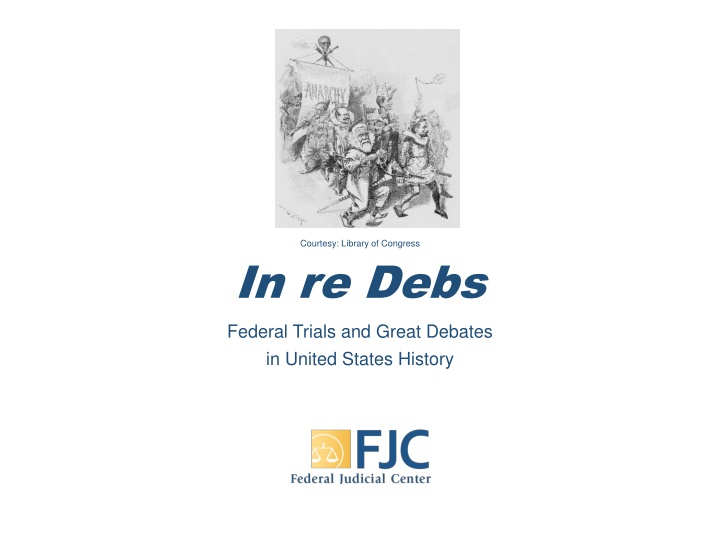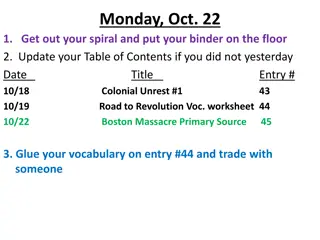The Pullman Strike of 1894: Eugene Debs and Labor Unrest
The Pullman Strike of 1894 was a pivotal event in American labor history, led by Eugene Debs and the American Railway Union against the Pullman Company's unfair labor practices. Workers protested wage cuts and living conditions, sparking a nationwide strike that disrupted rail traffic. Despite facing adversity and criticism, Debs emerged as a prominent figure in the labor movement, advocating for workers' rights during a turbulent period of industrial action and social unrest.
Download Presentation

Please find below an Image/Link to download the presentation.
The content on the website is provided AS IS for your information and personal use only. It may not be sold, licensed, or shared on other websites without obtaining consent from the author.If you encounter any issues during the download, it is possible that the publisher has removed the file from their server.
You are allowed to download the files provided on this website for personal or commercial use, subject to the condition that they are used lawfully. All files are the property of their respective owners.
The content on the website is provided AS IS for your information and personal use only. It may not be sold, licensed, or shared on other websites without obtaining consent from the author.
E N D
Presentation Transcript
Courtesy: Library of Congress In re Debs Federal Trials and Great Debates in United States History
The Pullman Company The Pullman Palace Car Co. was the nation s largest railway car manufacturer in the late 19th century. The company was run by George Pullman, a wealthy industrialist. In 1880, he constructed the company town of Pullman, Illinois. It included a factory and homes for many of his workers. The Pullman factory (circa. 1900) Courtesy: Library of Congress 2
The Pullman Company Workers received two paychecks, one of which they returned to the company for rent if they lived in the town. Pullman thought the town showed his generosity to employees. Critics argued corporations like Pullman s were trying to control workers lives. The company forbade union activity in the town. The Pullman Palace Car Co. factory (circa. 1900) Courtesy: Library of Congress 3
The Pullman Strike Begins From 1893 to 1897, the United States suffered a severe economic depression. As demands for Pullman cars dwindled, Pullman fired some workers and sharply reduced the wages of others. He did not reduce the rents he charged for the houses in the company town. Workers decided to strike in protest. George M. Pullman Courtesy: Smithsonian Institute 4
Eugene Debs Eugene V. Debs was the head of one of the nation s largest rail unions, the American Railway Union. In June, 1894, the ARU voted to join the Pullman strike. Although Debs was initially wary of the strike, he became its figurehead. Eugene V. Debs Courtesy: Library of Congress 5
Industrial Action in the 1890s Strikes were risky in the late 19th century. Prior to 1935, most workers could be fired for organizing unions or striking. In some instances, corporations hired private police forces to break up strikes with violence. Strikers were not always popular with the public. The Pullman strike was controversial because it came during a depression and the economy relied on rail transport. Cartoon depicting Debs as the king of anarchy Courtesy: Library of Congress 6
The Pullman Strike The ARU boycotted all trains carrying Pullman cars and blockaded rail lines. Tens of thousands of ARU members participated in the strike. A group of railroad companies fired strikers and attached Pullman cars to their trains. They refused to move trains from which strikers had removed Pullman cars. The strike and the railroads reaction disrupted almost all rail traffic west of Chicago. Satirical cartoon depicting king Debs blocking the rails Courtesy: Library of Congress 7
Federal Response The impasse between the unions and the railroads threatened to deepen the economic crisis. On July 3, 1894, President Grover Cleveland ordered federal troops into Chicago. The troops patrolled railyards to stop strikers blockading trains. President Grover Cleveland Courtesy: Library of Congress 8
Federal Response The government also sought injunctions in federal courts. Courts across the nation granted dozens of orders against the strike. The most important came from the U.S. Circuit Court for the Northern District of Illinois, which included Chicago, the center of the strike. President Grover Cleveland Courtesy: Library of Congress 9
Injunctions Injunctions are court orders prohibiting individuals or groups from committing specified acts. In this case, the government requested the injunction on three main grounds: The strike was interfering with the mail; The strike was interfering with interstate commerce; and The ARU was violating the Sherman Anti-Trust law, which prohibited combinations that restrained trade. The circuit court issued an injunction against Debs and several other union leaders. 10
Violence and Contempt of Court After the court issued the injunction, Debs continued to work with the ARU s local branches and the strike intensified. Protesters clashed violently with troops. 30 workers died and many more were injured. Troops clashed violently with workers Courtesy: Library of Congress 11
Violence and Contempt of Court In the wake of the violence, the Court cited Debs for contempt of court and sentenced him to six months in prison. Federal authorities also brought a separate criminal prosecution against Debs and his colleagues. That case was ultimately abandoned. Troops clashed violently with workers Courtesy: Library of Congress 12
Habeas Corpus Debs petitioned the Supreme Court for a writ of habeas corpus. Habeas corpus is a legal mechanism for challenging the validity of a detention. In this instance, it served as a challenge to the legality of the circuit court s injunction. Attorney Clarence Darrow Courtesy: Library of Congress 13
Habeas Corpus Debs lawyers included the famed advocate Clarence Darrow and former U.S. Senator Lyman Trumbull. They argued that the court should not have granted the government an injunction on three grounds: The government had no legal interests at stake in the case; The anti-trust law was designed to stop monopolies, not unions; Debs had been denied his right to a jury trial. Attorney Clarence Darrow Courtesy: Library of Congress 14
The Supreme Court Rules The Supreme Court unanimously upheld Debs conviction. Justice David Brewer s opinion sustained a broad injunction power in labor cases. Brewer emphasized that the U.S. government had the right to regulate interstate commerce and the mail. The government had to be able go to courts to enforce its regulations using injunctions. Justice David Brewer Courtesy: Library of Congress 15
The Supreme Court Rules The Court also held that Debs had not been deprived of his right to a jury. Judges had the power to issue injunctions without juries. The ability to punish those who ignored injunctions was an essential part of the injunction power. The Court did not address whether the Sherman Act applied to unions, but later cases held that it did. Justice David Brewer Courtesy: Library of Congress 16
The Aftermath The ARU dissolved in the wake of In re Debs. Debs continued working in the labor movement after his release from prison. He ran as a socialist candidate for president five times. In 1917, he was again imprisoned for criticizing America s entry into World War I. The Supreme Court upheld his conviction against a free speech challenge in 1919. He won approximately 3% of the popular vote from prison. Debs on his release from prison (1921) Courtesy: Library of Congress 17
Legacy of the Case In the years following Debs, federal courts issued thousands of strike- busting injunctions. The use of injunctions was very controversial and critics complained of government by injunction. Some historians argue the courts weakened the labor and socialist movements in the U.S. In 1932, Congress passed a law prohibiting courts from issuing injunctions in labor cases. Eugene V. Debs Courtesy: Library of Congress 18























